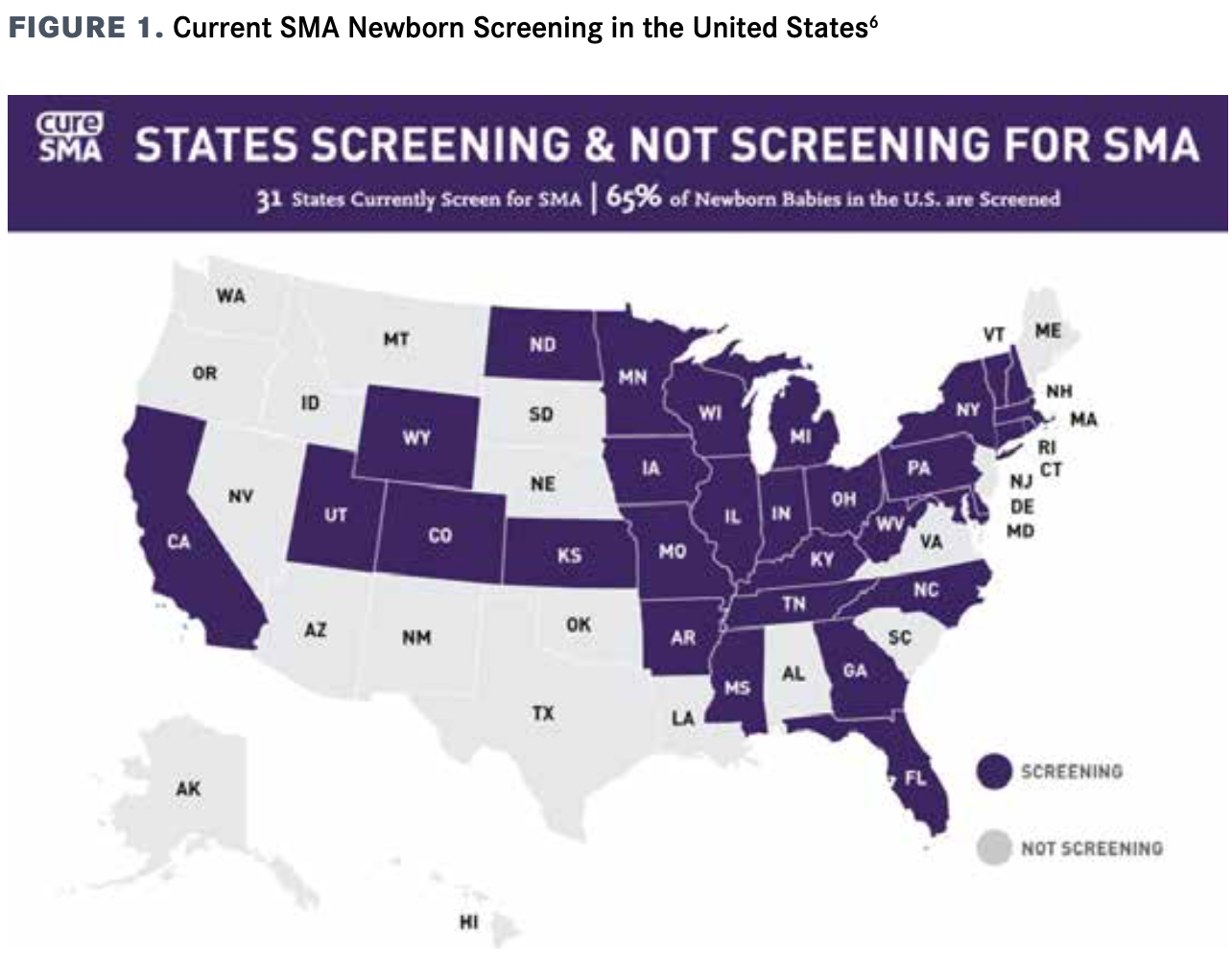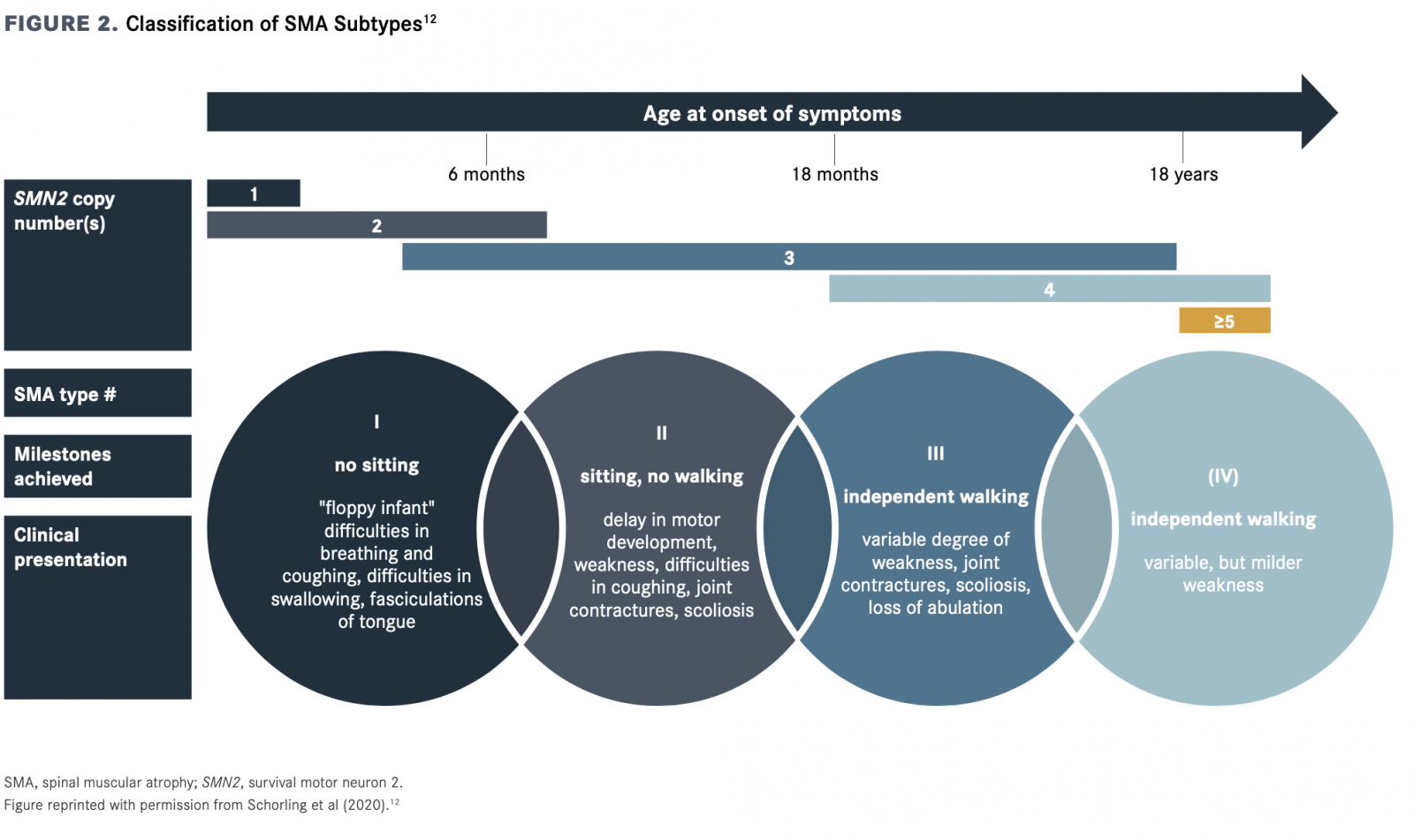Publication
Article
NeurologyLive
Early Intervention in SMA: How Access to Therapy Will Alter Disease Management As We Know It
Author(s):
Efforts to cut through regulatory red tape will help ensure earlier access to potentially lifesaving treatments.

Mary Schroth, MD
Three disease-modifying treatments for spinal muscular atrophy (SMA) that have been approved all have different mechanisms of action but at least 1 shared property: They work best when early detection of SMA enables affected patients to receive them sooner rather than later.
Prior to the approval of the first gene-modifying therapies for SMA—nusinersen (Spinraza; Biogen) in 2016,1 onasemnogene abeparvovec (Zolgensma; AveXis) in 2019,2 and risdiplam (Evrysdi; Genentech) most recently in August 2020,3 only supportive therapy was available and its timing did not alter the progressive loss of motor neurons in this autosomal recessive neuro-degenerative disorder.
“Time is neurons,” commented Mary Schroth, MD, chief medical officer at Cure SMA, a national patient advocacy and educa-tion organization. “Both the treatments that are available are disease-modifying treatments. Neither of them are cures, but they are life-changing.”
Although SMA is the leading genetic cause of infant mortality,4little progress had been made toward widespread newborn screening for early detection before the advent of gene therapies. The incorporation of SMA into newborn screening quickened with the evident success and FDA approval of nusinersen.
In response to encouraging data, the Maternal and Child Health Bureau of the Health Resources and Service Administration (HRSA) advised in 2018 that SMA be added to the Recommended Uniform Screening Panel (RUSP) in the United States.5
“Based on what is known about screening and the risk of being born with SMA, experts think that screening all newborns in the United States for SMA would find about 36 babies with the disorder each year,” the HRSA report stated.4 “Each year, screening could prevent about 50 infants from needing a ventilator and about 30 deaths due to SMA Type 1.”
Inclusion in the RUSP does not mandate nationwide implementation, however, as implementation of the screen for newborns is determined by each state. According to tracking by Cure SMA, newborn screening for SMA has currently been adopted and implemented in 23 states, adopted but not yet implemented in 14 states, and undertaken as a pilot project in 3 states (FIGURE 1).6

“Each state is independent in their identification of a specific SMA screening test, and the way that they go about launching it,” Schroth told NeurologyLive®. “In some states, it’s mandated by their state law that implementation occurs within a certain period of time after inclusion in RUSP.
“It is a state-by-state process,” she said, “which makes it challenging for patient advocacy organizations such as Cure SMA, and also for families because it may depend on which side of a state line you’re on as to whether the infant born today is screened or not for SMA.”
Initiatives from Cure SMA to promote newborn screening and early diagnosis include outreach to state legislators and public health laboratories, as well as maintaining an online newborn screening registry7 for data that could help support new therapy development and improve clinical care. One of its education programs, SMArt Moves, provides separate materials for families and for health care providers to increase knowledge about SMA and recognition of the disorder’s signs and symptoms.8
With the increased emphasis on newborn screening for SMA that followed the advent of gene therapies, there has also been increased consideration of testing for carriers. Carrier testing for SMA had previously been recommended for all pregnant women by the American College of Medical Genetics and Genomics9 and the American College of Obstetricians and Gynecologists.10
In a recent article, bioethicists argued for increasing the availability of carrier screening to identify potential risk and inform family planning.11
“The dual developments of increased treatment options for SMA, Zolgensma and Spinraza, and the increased sophistication of genetic screening technologies prompted us to look at this topic,” Christopher Gyngell, PhD, of the Department of Pediatrics at the University of Melbourne and the Murdoch Children’s Research Institute in Australia, told NeurologyLive®.
“These developments are leading to novel ethical challenges from both a clinical and policy standpoint,” Gyngell said.
In their analysis, Gyngell and colleagues argued that a moral imperative exists to pursue ex-ante interventions, such as carrier screening, in combination with prenatal testing and preimplantation genetic diagnosis or gene editing to reduce the incidence of SMA. They argue further that such ex-ante methods should be prioritized over ex-post methods for reasons related to autonomy, beneficence, and justice.
“One thing we touch on,” Gyngell commented, “is that carrier screening can lead to cost savings for health systems, which can be reinvested into other programs. Screening programs can therefore help build more sustainable health systems.”
Treatment Recommendations Follow New Evidence
The genetic screen for SMA is based on the determination that 95% of cases result from a homozygous deletion in the SMN1 gene that encodes the survival motor neuron (SMN) protein. In the other 5% is a mutation rather than an SMN1 deletion, which is not detected in screening.12
The loss of SMN protein results in degeneration of anterior horn cells in the spinal cord, with resulting fatigue, paralysis, and atrophy of the proximal muscles.12 There is, however, an inherent mitigation, in that most individuals retain function of 1 or more copies of the paralogous SMN2 gene.
SMN2 also encodes the SMN protein, albeit in a lower amount.12 As the severity of the condition is related to the amount of available SMN, the severity is less in individuals with more copies of SMN2 (FIGURE 2).12

An SMA treatment algorithm based on early detection was developed through expert consensus by a working group convened in 2018 by Cure SMA.13 The group considered preclinical and clinical data (notably from presymptomatic infants in the ongoing NURTURE trial)14 to confirm that the best outcomes occur when disease-modifying therapy agents are given as early as possible.
They found strong evidence, however, that irreversible loss of motor neurons with SMA type 1 begins early in the perinatal period, “with severe denervation in the first 3 months and loss of more than 90% of motor units within 6 months of age.”13
The working group recognized that the majority of infants with SMA who have 1 copy of SMN2 would be symptomatic at birth, and they would be likely to have sustained loss that would not be remediated with disease-modifying therapy.
“In this case, the consensus is to defer to the attending physician to determine if the infant and family would benefit from treatment given his or her current disease state,” they indicated. “In the rare event that an infant with SMA with 1 copy of SMN2 is truly presymptomatic, the strong consensus is that the infant should be treated immediately.”
The 2018 working group was unanimous in recommending that immediate, presymptomatic treatment should be provided for all infants with 2 or 3 copies of SMN2. The group was split, however, on whether to extend that recommendation to infants with 4 or more copies.13
They reached a consensus that infants with 4 or more copies of SMN2 should be “screened carefully for the first presentation of symptoms” rather than receive gene-modifying therapy immedi- ately after the condition is detected.
The working group was reconvened in 2019 to consider newly emerging data, including additional findings in the NURTURE trial that nusinersen treatment, when given to infants with 2 or 3 copies of SMN2 who were aged under 6 weeks, was associated with significantly better outcomes than treatment given after the age of 6 weeks.15
“Patients enrolled in this trial with 2 copies of SMN2 have a dramatically altered disease course with 100% alive, 100% sitting, 88% walking with assistance, 77% walking independently, and none needing the use of permanent ventilation assistance,” the 2019 working group recounted.16
From these results, the group extrapolated that such outcomes were as likely to be attained in infants with 4 copies of SMN2 as in those with 3 copies. The working group now recommends that these infants also receive disease-modifying therapy while presymptomatic, immediately after detection in newborn screening.16
“With early treatment, disease should be mostly eradicated in presymptomatic patients with 4 copies of SMN2,” they concluded. Schroth emphasized that the rapid progress in treatment and notable clinical trial data that emerged after the first meeting had compelled the working group to reconvene.
“As a result of these therapies being available and clinical trials with additional treatments, clinicians have had more experience utilizing these treatments and understanding the risks and benefits,” she said. “There was a clear majority when they reconvened.”
Addressing, Averting a Devastating Course
SMA phenotypes have traditionally been categorized by the severity of symptoms and the age at onset, in the natural course without disease-modifying therapy, as well as by life expectancy and the motor function milestones that are attained.
In a 2020 journal article, Janbernd Kirschner, MD, of the Department of Neuropediatric and Muscle Disorders at the Medical Center—University of Freiburg in Germany, and colleagues described the presentations associated with the traditional phenotypes, noting that the most severe, type 1, affects more than half of patients with SMA and manifests within the first 6 months of life.12
“A ‘floppy infant’ presentation, [with] reduced spontaneous movements, and a paradoxical breathing pattern are characteristic; these infants fail to achieve the free sitting milestone,” Kirschner and colleagues wrote. “SMA type 2 is characterized by a milder course,” they continued, “with onset of symptoms between the ages of 6 and 18 months. Per definition, these patients do manage free sitting, but not independent walking. The latter is achieved, at least temporarily in patients with SMA type 3, whose symptoms’ onset is during infancy or adolescence.
“In addition, some classifications define SMA type 0 and SMA type 4 with prenatal onset or a very mild phenotype entailing an adult onset of symptoms, respectively,” Kirschner and colleagues added.
They point out that disease-modifying drugs, age of onset, number of SMN2 copies, and the age at start of drug treatment will better define a clinical phenotype of SMA going forward than the traditional subtypes.
“These new disease trajectories also mean [that] we must modify and adapt the clinical approach taken,” they wrote.
This is especially relevant with the longer survival that is achieved without ventilation support following initiation of drug treatment. This “needs to be considered when counseling the parents of patients with early-onset types of SMA,” they suggested.
Kirschner and colleagues also pointed out that, despite the improved survival and motor development of symptomatic patients with early-onset SMA, these children also exhibit a higher rate of scoliosis during the first years of life.
“Greater awareness of this risk, and close monitoring of spinal deformities, [appears] crucial to react early and enable the spine to be stabilized via medial orthosis,” they wrote.
Optimal long-term outcomes will require multidisciplinary care, according to Jule Parsons, MD, professor of clinical pediatrics and neurology and codirector of the Neuromuscular Clinic at the University of Colorado Anschutz Medical Campus/Children’s Hospital Colorado in Aurora.
“We are following them to see what that actually is going to mean and look like,” Parsons told NeurologyLive®. “So, it is important to have assess- ments by expert clinicians, in terms of looking at motor outcomes, pulmonary outcomes, growth and weight gain, bone health—we look at and monitor a number of different issues.
“We also have to remember the current population of patients— children and adults with SMA—and [they] can be extremely complex patients who may also benefit from some of the new therapies that are coming,” Parsons said, referring mainly to risdiplam, Roche/ Genentech’s recently-approved therapy3 that has proved safe and effective in a wide range of patients with SMA, from infants to adults. The therapy, which was approved for use in adults and children with SMA types 1, 2, or 3 age 2 months and older,3 is an orally adminis- tered SMN2 splicing modifier associated with a range of benefits, including significant change in total Motor Function Measure 32 in younger patients and disease stabilization in older ones.17
In a recent review,18 Parsons and colleagues noted that updated standards of care19 offer 3 general phenotype categories that are determined by motor function class: nonsitters, sitters, and ambulant. Each, they explained, has particular considerations and care needs.
“What I’m seeing is that these patients benefit from the new therapies. They continue to have enhanced motor skills,” Parsons said, “and, frankly, some of the children that we’ve followed have actu- ally met normal motor milestones, the same as for a child who doesn’t have SMA.
“With early [disease-modifying] treatment, we don’t necessarily need to use nonoral therapy, such as feeding tubes, and the respiratory support may be less than what we would have needed in the previous standard of care,” Parsons said.
Schroth agreed that the treatment landscape has changed with the advent of new, effective therapies, and that this has posed both opportunities and challenges to realize them.
“There’s less confidence about what sort of intervention the baby will require,” she acknowledged. “And so now we’re in the stage of trying to better understand the impact of these treatments across the disease spectrum, and what things need to be carefully monitored and acted upon.”
REFERENCES
1. FDA approves first drug for spinal muscular atrophy. News release. FDA; December 23, 2016. Updated March 28, 2018. Accessed June 12, 2020. https://www.fda.gov/news-events/press-announcements/ fda-approves-first-drug-spinal-muscular-atrophy
2. FDA approves innovative gene therapy to treat pediatric patients with spinal muscular atrophy, a rare disease and leading genetic cause of infant mortality. News release. FDA; May 24, 2019. Accessed June 12, 2020. https://www.fda.gov/news-events/press-announcements/ fda-approves-innovative-gene-therapy-treat-pediatric-patients-spinal-muscular-atrophy-rare-disease
3. PTC Therapeutics announces FDA approval of Evrysdi (risdiplam) for the treatment of spinal muscular atrophy in adults and children 2 months and older. News release. PTC Therapeutics; August 7, 2020. Accessed August 7, 2020. https://www.finance.yahoo.com/news/ptc-therapeutics-announces-fda-ap- proval-175400735.html
4. Prior TW. Perspectives and diagnostic considerations in spinal muscular atrophy. Genet Med. 2010;12(3):145-152. doi:10.1097/GIM.0b013e3181c5e713
5. Newborn screening for spinal muscular atrophy. a summary of the evidence and advisory committee decision. Health and Resources and Services Administration. March 13, 2018. Accessed June 12, 2020. https://www.hrsa.gov/sites/default/files/hrsa/advisorycommittees/heritable-disorders/rusp/previ- ous-nominations/sma-consumer-summary.pdf
6. Newborn screening for SMA. Cure SMA. Updated July 1, 2020. Accessed July 6, 2020. https://www. curesma.org/newborn-screening-for-sma/
7. Cure SMA newborn screening registry (NBSR). Cure SMA. Accessed June 15, 2020. https://www. curesma.org/nbsr-sep2019/
8. SMArt Moves. Cure SMA. Accessed June 15, 2020. https://www.curesma.org/smartmoves/
9. Prior TW; Professional Practice and Guidelines Committee. Carrier screening for spinal muscular atrophy. Genet Med. 2008;10(11):840-842. doi:10.1097/GIM.0b013e318188d069
10. Committee Opinion No. 691 summary: carrier screening for genetic conditions. Obstet Gynecol. 2017;129(3):597-599. doi:10.1097/AOG.0000000000001948
11. Gyngell C, Stark Z, Savulescu J. Drugs, genes and screens: the ethics of preventing and treating spinal muscular atrophy. Bioethics. 2020;34(5):493-501. doi:10.1111/bioe.12695
12. Schorling DC, Pechmann A, Kirschner J. Advances in treatment of spinal muscular atrophy—new phenotypes, new challenges, new implications for care. J Neuromusc Dis. 2020;7(1):1-13. doi:10.3233/JND-190424
13. Glascock J, Sampson J, Haiet-Phillips A, et al. Treatment algorithm for infants diagnosed with spinal muscular atrophy through newborn screening. J Neuromusc Dis. 2018;5(2):145-158. doi:10.3233/JND-180304
14. De Vivo DC, Hwu W-L, Reyna SP, et al. Interim efficacy and safety results from the phase 2 NURTURE study evaluating nusinersen in pre-symptomatic infants with spinal muscular atrophy. Neurology.2017;88(16 Supplement):S46.003.
15. Biogen announces new data further establishing Spinraza (nusinersen) as a foundation of care in spinal muscular atrophy for a broad range of patients. News release. Biogen; July 1, 2019. Accessed June 16, 2020. https://investors.biogen.com/news-releases/news-release-details/ biogen-announces-new-data-further-establishing-spinrazar
16. Glascock J, Sampson J, Connolly AM, et al. Revised recommendations for the treatment of infants diag- nosed with spinal muscular atrophy via newborn screening who have 4 copies of SMN2. J Neuromusc Dis. 2020;7(2):97-100. doi:10.3233/JND-190468
17. Genentech’s risdiplam showed significant improvement in motor function in people aged 2-25 with type 2 or 3 spinal muscular atrophy. News release. Genentech; February 6, 2020. Accessed April 7, 2020. https//www.gene.com/media/press-releases/14836/2020-02-06/ genentechs-risdiplam-showed-significant-
18. Gibbons M, Stratton A, Parsons J. Spinal muscular atrophy (SMA) in the therapeutic era. Curr Genet Med Rep. 2019;7:162-167. doi:10.1007/s40142-019-00172-9
19. Mercuri E, Finkel RS, Muntoni F, et al; SMA Care Group. Diagnosis and management of spinal muscular atrophy: part 1: recommendations for diagnosis, rehabilitation, orthopedic and nutritional care. Neuromuscul Disord. 2018;28(2):103-115. doi:10.1016/j.nmd.2017.11.005





